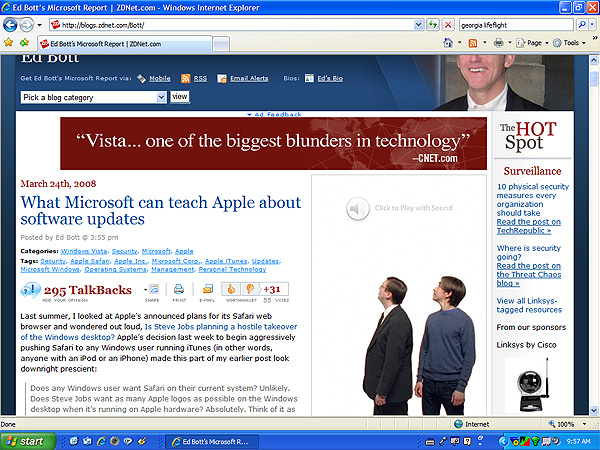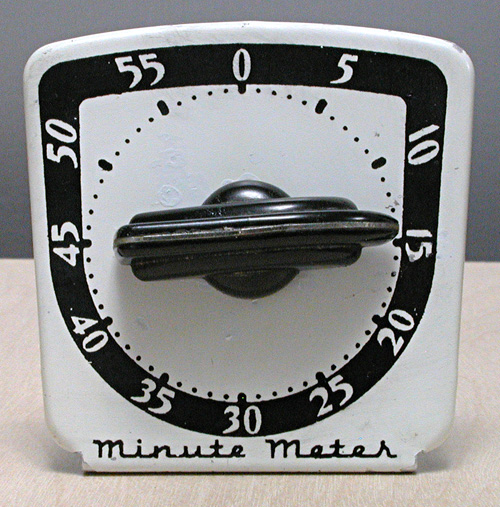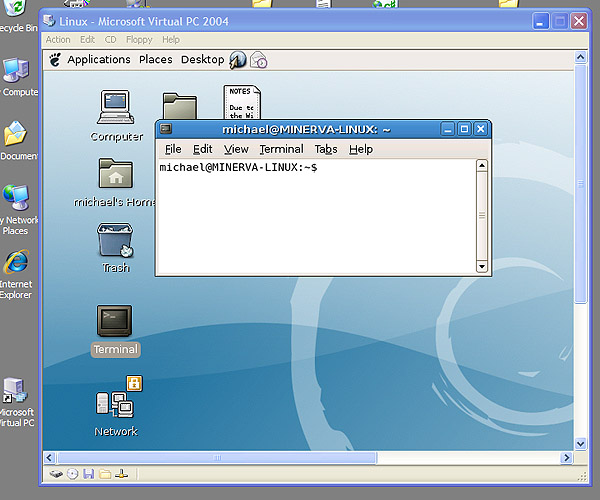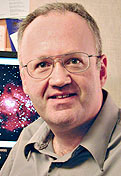 |
|
2008
March
30-31
|
Short notes, long month
I'll go ahead and close out the month of March now with an assortment
of short items.
When I resume posting in April, I'll probably be using a different laptop, a Dell
D850 with Windows Vista instead of this Dell D610 with XP.
Hence my recent acute interest in Windows Vista.
 I've been busy. A big research project is revving up; click on the picture and you'll
be taken to its web site, where you can learn nearly nothing about it.
The web site will be more informative later, I promise.
I've been busy. A big research project is revving up; click on the picture and you'll
be taken to its web site, where you can learn nearly nothing about it.
The web site will be more informative later, I promise.
In other news...
A romantic tragicomedy of the Internet: Read
this story, which is reportedly true. As always, people you meet on the Internet
(or anywhere else) aren't necessarily what they claim to be. The way this particular one
was found out is worthy of Hercule Poirot.
Microsoft WPF (the new GUI for Windows programming)
is apparently
good for
image processing.
And finally, for real computer nerds from the 1970s: You can have
a CYBER on your desktop,
although it isn't cheap.
Today a PC can emulate a CDC CYBER computer well enough to be productive.
It may even be considerably faster than a real CYBER; the clock speed is,
after all, about 100 times greater!
Look at the console screen shots.
In the old days, a CYBER had two CRTs, or, later, a single CRT with two blocks of text.
See also my 2004 entry about
the last time I used a real CYBER.
Permanent link to this entry


|

|
2008
March
29
(Extra)
|
Major e-mail failure
All day on Friday, March 28, the University of Georgia had major problems with its
e-mail system.
Mail sent to uga.edu was often rejected as undeliverable, but in many cases
was delivered anyhow.
More seriously, mail sent from uga.edu was sent out anywhere from 0 to 10 times.
It's remarkable how little work we could get done without our e-mail system.
As of 8 p.m., the problem has diminished but may not be completely gone.
This is another reminder that computers don't work by magic —
they are machines with finite reliability.
Permanent link to this entry


|

|
2008
March
29
|
Too much negative campaigning!

Too much negative campaigning!
I don't mean the presidential race.
I'm referring to Apple's generously-funded campaign to kill off Windows Vista
by spreading the word that it is "bad" in some unspecified way.
If Vista is that bad, will somebody tell me what's wrong with it?
I don't just mean "it doesn't have a driver for the Bozo Supercheap Scanner
that I bought in 1998." Admittedly, Vista has a shortage of drivers for
older hardware, because of architectural changes that greatly limit the ability
of drivers to crash the system, and at the same time prevent badly written
drivers from running at all. (Many XP device drivers do work under Vista.)
Above you see a screenshot of Ed Bott's column criticizing, deservedly,
Apple's heavy-handed software update tactics, which reportedly include
imposing a new web browser (for Windows) on every iTunes subscriber whether
they want it or not. (Click on the picture to read the column.)
And in the ad banners, you see those two Apple men ("I'm a PC," "I'm a Mac") looking
at quotes saying Vista is dreadful in some unspecified way.
What bothers me about the "I'm a PC," "I'm a Mac" TV ads is that
they don't give any information about computers. They seem to be aimed
at the totally ignorant. You're just supposed to take their word that PCs are
bad and Macs are good, because some higher authority somewhere says so but
doesn't give any reasons.
Or when they do give reasons, they're illogical.
For instance, they claim Vista is massively inconvenient because it asks you
for permission whenever software tries to reconfigure your computer.
Mac users, I suppose, prefer to ride without a helmet.
We need more criticism and less whining. Apple, please tell us the strong
points of MacOS; it has some, but you're not revealing them.
Everybody else, if you don't like Vista, tell us what's wrong with it
and go beyond just saying, "My friend-of-a-friend had a bad experience,
but it might have been defective hardware, but nonetheless I always blame
software when the computer doesn't work."
Afterthought: Perhaps the real problem with Vista is that
it looks too different from XP. People go by the superficial appearance
of the screen rather than what's under the hood. Remember the fear and panic
when Windows XP came out? XP is little more than Windows 2000 redecorated, but
people assumed that because the windows were different-looking, it
couldn't possibly run their old software.
Vista is much more than Windows XP redecorated. In fact, you can turn off the
redecoration. Choose the "Classic" desktop theme and it will look remarkably like
Windows 2000.
By the way, what are they quoting?
The CNET item that described Vista as "one of the biggest blunders in technology"
was not a product review.
It was this blog entry,
almost devoid of
information about Windows Vista.
In fact the one technical point on which it does criticize Vista — the fact
that it asks for permission to run downloaded software — is not a new feature
of Vista! It's been there since XP SP1, it serves to protect people against a very
important security hazard, and of course one of the options is, "Don't ask me again."
Part of the Mac mindset seems to be no security.
Permanent link to this entry


|

|
2008
March
28
|
Mars and Saturn
I did a bit of planet imaging this evening (Mar. 27), using my 8-inch telescope and
webcam, taking more than the usual number of video frames (two to four thousand for
each of these).
Mars is a long way from us now — more than twice the distance that is considered
good for viewing it — but I was able to record the south polar cap (top),
north polar cap (bottom), and Mare Acidalium (the dark streak at the lower left),
as well as a white area at the upper left that may be a dust storm.

Saturn is well placed for observation, although as you can see, the rings are
closer to being edge-on to us than they were last year.

Permanent link to this entry
Pictures for sale
Some astrophotos that were in my two art exhibits are available.
These are giclée prints in archival acid-free mats, framed under glass.
some 16×20 in 22×28-inch frames and some
8×10 in 16×20 frames.
Subjects available include: moon (gibbous); lunar eclipse; Comet Holmes; Orion Nebula;
M31 (Andromeda Galaxy); Rosette Nebula; Lagoon Nebula; star cloud M24; star clouds
and nebulae in central Cygnus.
E-mail me if you want to know more. Serious inquiries only, please.
Permanent link to this entry


|

|
2008
March
27
|
Busy
I'm too busy — or tired — to write anything, but have a look at
the BBC's collection
of Sherlock Holmes fanfiction.
My art show at the Georgia Center for Continuing Education (South Lumpkin St., Athens, Georgia)
ends at 4 p.m. on Thursday, the 27th (today, if you are reading this promptly).
Permanent link to this entry


|

|
2008
March
26
|
The least-known fact about Windows Vista
Perhaps the best-known fact about Vista is that it is not good at supporting older
hardware that requires unusual drivers, such as webcams or printers that do not use a standard
printer control language.
I think I've identified the least-known important fact about Vista:
It has a warranty.
Here are some quotes from the Vista Home Premium terms of use:
LIMITED WARRANTY. If you follow the instructions and the software is properly licensed, the
software will perform substantially as described in the Microsoft materials that you receive in or with
the software.
TERM OF WARRANTY; WARRANTY RECIPIENT; LENGTH OF ANY IMPLIED WARRANTIES.
The limited warranty covers the software for one year after acquired by the first user. If
you receive supplements, updates, or replacement software during that year, they will be
covered for the remainder of the warranty or 30 days, whichever is longer. ...
REMEDY FOR BREACH OF WARRANTY. Microsoft will repair or replace the software at
no charge. If Microsoft cannot repair or replace it, Microsoft will refund the amount
shown on your receipt for the software. It will also repair or replace supplements,
updates and replacement software at no charge. If Microsoft cannot repair or replace
them, it will refund the amount you paid for them, if any. You must uninstall the
software and return any media and other associated materials to Microsoft with proof of
purchase to obtain a refund. These are your only remedies for breach of the limited
warranty.
This is a far cry from the 1980s, when all software was always supplied "as-is" with
copious disclaimers no matter how much it cost. OS/2 was the first operating system I saw
with a warranty, around 1989. It started a trend.
Having said that, I wonder... Has anybody ever actually made a warranty claim?
Permanent link to this entry


|

|
2008
March
25
|
Notepad++
I've switched to Notepad++
for my text editing, instead of Programmer's Notepad (which lacked macros),
which I adopted instead of Crimson Editor (which wasn't multiuser-aware).
Notepad++ is fast and apparently reliable, and it includes the ability to collapse sections
of a program in outline form. This even works for LaTeX.
Naturally I'm changing a lot of defaults. The only really annoying habit of
Notepad++ is that it likes to display comments in small green type in the Comic Sans
font. To fix this:
(1) Open the file %AppData%\Notepad++\stylers.xml.
(2) Change all fontName="Comic Sans MS" to fontName="".
(3) Change all fontSize="8" to fontSize="".
(4) Save and exit.
You will probably also want to use Notepad++'s menus to change the "Default Style" font
to Consolas, 11 point. Consolas is a Vista font (also distributed with Office updates)
which is unusually legible and has the great virtue that its characters are the same width
whether or not boldfaced.
Alternatively, if you want to run Notepad++ my way, just:
(1) Download my versions of
stylers.model.xml and
config.model.xml.
(2) Place them in %ProgramFiles%\Notepad++
in place of the files already there with the same names.
(3) Delete %AppData%\Notepad++\stylers.xml
and %AppData%\Notepad++\config.xml.
(4) Launch Notepad++.
You will have gathered that the "model" XML files in %ProgramFiles%\Notepad++
set the defaults for all users, and the ones without "model" in their name are
generated from them for each individual user.
You will also have gathered that the environment variables %ProgramFiles%
and %AppData% stand for the locations of the program files and the per-user
application data for your account, whether you're running Windows 2000, XP, or Vista.
Permanent link to this entry


|

|
2008
March
24
|
Easter puzzle
Professor
Mankiw's Easter card (in his blog) is more cryptic than mine (below).
His says "Christ is risen" in Russian or Ukrainian (on those 2 words the two
languages are the same) accompanied by a picture of an imaginary
oviparous rabbit. I'm puzzled.
Anyhow, Russian Orthodox Easter isn't for about a month yet.
They don't follow the same calendar as western Christians.
So I'm doubly puzzled.
Permanent link to this entry
Decompiling C#
C# programs can be decompiled — that is, you can use
Reflector to get
the source code back from the .EXE or .DLL. In fact, you can decompile
into C#, Visual Basic, Managed C++, Delphi, or a couple of other languages.
It's uncanny how much the output resembles the original program.
If you have the debugging (.PDB) file, you even get the original
variable names.
I hope to say more about this in the future, but today I just want to observe
what it means:
under .NET, all programs are effectively open-source.
This is good in two ways: you can't keep secret how your program works,
and if your program fails, others can, in principle, fix it,
even if you've gone out of business or disappeared.
But it's bad if you rely on secrecy to protect your products, or if you're
ashamed of how badly you program and don't want anybody to know what's inside.
Permanent link to this entry


|

|
2008
March
23
|
|
Feast Day of the Resurrection of Our Lord

But Thomas, one of the twelve, called Didymus, was not with them when Jesus came.
The other disciples therefore said unto him, We have seen the LORD. But he said unto them, Except I shall see in his hands the print of the nails, and put my finger into the print of the nails, and thrust my hand into his side, I will not believe.
And after eight days again his disciples were within, and Thomas with them: then came Jesus, the doors being shut, and stood in the midst, and said, Peace be unto you.
Then saith He to Thomas, Reach hither thy finger, and behold my hands; and reach hither thy hand, and thrust it into my side: and be not faithless, but believing.
And Thomas answered and said unto him, My LORD and my God.
— John 20:24-28 (KJV)
The lesson of St. Thomas the Apostle is:
What if you ask God for proof, and He gives it to you?
What will you do then?
We wish all of you a blessed Easter!
|
Permanent link to this entry


|

|
2008
March
22
|
A few things of note
What Ed Bott discovered
about a sluggish Sony laptop: It was burdened by "free trial" software,
far too much of it. For a short time, Sony actually had the
audacity to charge an extra
fee for laptops without the free trial junk.
A UNIX
subsystem for Vista, similar to
the one for XP
that I've used occasionally.
A memorable piece
of "British light music." If you're my age, it reminds you of something else.
Yes, "Puffin' Billy" (which was supposed to be about a steam locomotive)
is the "circus music" that was the theme for Captain Kangaroo.
Permanent link to this entry


|

|
2008
March
21
|
Planetarium
I'm delighted to see that the
planetarium
in Valdosta is still going strong,
still with its 40-year-old
Spitz A-3-P
projector.
A visit to the planetarium in sixth grade, in April 1968, was a highlight of my
early life. Around 1970-71 I learned how to operate this planetarium projector,
under the guidance of Edward Van Peenen II (where is he now?).
Click here for a guide
to the Spitz control panel. This was 1968 — no computers! There's no digital
circuitry anywhere in it. It's done with clockwork, electric motors, and a lot of
light sources and lenses.
A planetarium can be almost indispensable for getting acquainted with how the sky
moves. The real sky never looks anything like a map. The planetarium does look like
the real sky; you can look around in all directions;
and with a flip of a switch you can see it the way an astronomer does —
ablaze with coordinate lines!
The last time I was in a planetarium was several years ago, to see the new
Zeiss
projector at Agnes Scott College.
I was with a good-sized group, and I didn't know any of the local astronomers very well,
so I didn't get a look at the controls.
Permanent link to this entry


|

|
2008
March
20
|
Buy savings bonds...
A quick economic note:
Series I Savings Bonds
are about to become a
good investment again.
I expect their interest rates to reset to 5% or 6% in May
because the inflation rate is up.
Meanwhile, CD rates are down.
There's an advantage to buying them before the rate resets.
The rate is a fixed number of percentage points above the varying inflation rates.
When the rate resets, the fixed portion for new bonds also resets.
When inflation is low — as it has been — the fixed portion is higher.
Once you've bought a bond, the fixed part of the interest rate remains the same.
Permanent link to this entry


|

|
2008
March
19
|
Short notes
I've registered www.covbooks.com to link to information
about all of Melody's and my books. It may be working by the time you read this.
Vista Service Pack 1 is out. I downloaded it and it wouldn't install on my Vista machine
because I had (inter alia) the Italian language pack installed. A helpful error message told me this,
and I went to Control Panel, Regional and Language Options, and uninstalled Italian. Then the SP1
installation started up. An hour later, it's still going. I downloaded the whole thing and burned
it to a CD before starting, so it's not waiting for network connections; it's just doing a lot of work.
Update: Service Pack 1 installed in about an hour and runs just fine.
For more about what it accomplishes see
WinSuperSite.
Reportedly, the main advantage is that a lot more software and hardware becomes
compatible with Vista. At the same time, a few Vista device drivers aren't
compatible with Service Pack 1, and if you have them, Windows Update will not
offer Service Pack 1 to you.
Also see Microsoft's
Vista Team Blog for more about Service Pack 1.
The economy is in a tumult. Interest rates are low again; there's a hue and cry about
a recession; and the news media have discovered that
Americans
are turning frugal.
The British, too.
Even the
Church of England is
starting to dispense financial counseling.
Where can you get a credit card with an interest rate under 13%?
Try a credit union.
The next time I need something, I'm thinking of joining this one.
Speaking of churches, many of the media recently
falsely reported that the Vatican had released a
"new list of the Seven Deadly Sins."
Don't believe those confused reporters.
Get the straight story here.
Permanent link to this entry


|

|
2008
March
18
|
What makes it tick?
For the first time in my life I have repaired a mechanical clock. This required
learning how an escapement works — that is, learning exactly and literally
what makes it tick.
The clock was actually my grandmother's kitchen timer. It belonged to my father's
mother, Nellie Aaron Covington (1902-1976), and is at least 50 years old. I played
with it as a young boy and have had it since she died, although it hasn't been
used much.

My understanding is that this is a Lux product, essentially the same as one
that is still on the market.
It was first marketed in 1936
although this particular one probably dates from the 1950s.
I was going to just touch up the paint, but to my dismay, when I picked the timer up and tried
it yesterday, it didn't work.
So I opened it up and found that the axle marked with the arrow in the picture below had
jumped out of its bearings.

That is of course the axle that holds the escapement itself. By trial and error I got it
back in the right position and proceeded to clean and lubricate the mechanism and touch up
the exterior paint.
So what makes it tick? As I understand it, this mechanism is called an anchor
escapement and was invented in the 1600s by Robert Hooke.
At the right you see a
balance wheel,
which is a flywheel attached to a thin spiral spring (hairspring) so that if you turn it in the
direction that winds up the spring, and then release it,
it will bounce back, turning the other way.
At the left is a toothed wheel. Its teeth engage, alternately, two pins on an anchor-shaped piece
which rocks back and forth. Every time it rocks, it lets one tooth go by.
So what makes it rock back and forth at a fixed speed? The balance wheel.
Near (not at) the center of the balance wheel is a pin. At the far end of the anchor-shaped piece
are notches that can engage the pin at either extremity of the balance wheel's rotation
(two positions 180 degrees apart).
As the balance wheel goes back and forth, the
pin moves back and forth between two notches, knocking the anchor back and forth
and allowing the toothed wheel to advance.
Tick, tock, tick, tock...
And now you know. To see a rather poor video of the whole thing in action,
click here.
Permanent link to this entry
Storms
Readers will be relieved to know that the Atlanta tornadoes of March 15 did not
damage anything near me. I'm 75 miles east of Atlanta, and on Saturday afternoon, we had
several tornado warnings and a brief but tempestuous downpour, but no actual tornado damage
on the ground in our county. As this is written (Monday, March 17), downtown Atlanta is
largely shut down and we are waiting to assess the damage.
Permanent link to this entry


|

|
2008
March
17
|
A riddle
Here's a riddle for everyone this March 17th:
What nationality was St. Patrick?
If you say "Irish" you've missed the point.
St. Patrick brought Christianity to Ireland.
That means he came from somewhere else.
He came from the British mainland, probably near Carlisle
in northwest England.
Permanent link to this entry


|

|
2008
March
16
|
We're having a recession, so business is picking up...
Two good things happen to me whenever there's a recession:
the University gets better graduate students (which leads to better
research opportunities), and I get more consulting clients.
That is, I'm contra-cyclical. I seem to prosper, from two directions,
when times are hard for conventional businesses.
The news media are trying hard to organize a severe recession.
I say "organize" because one way to create hard times is to convince
everybody we're having hard times.
Realistically, though, things are not really very bad.
True, we're in a bear market, and it isn't as easy to borrow money as
it used to be. (Well, not as easy for most people. I'm still
getting unsolicited offers...) And the price of gasoline has risen.
But unemployment is still quite low, and the wheels of the economy
are still turning.
What has gone wrong?
Obviously, seriously inadequate regulation of the banking industry
led to overlending and then a credit crunch. That's a theme I've
harped on
for a long time (see also this).
And the price of gasoline has gone up — but what did you expect?
It was bound to do so eventually.
But a more intriguing proposal, made by
Edmund
Phelps, is that economists have overestimated their ability to predict.
Since the 1980s, the tools of monetary policy have been refined admirably.
But economists may have been lulled into thinking that nothing new would ever happen.
And new things are happening. One of the most important is "securitization" — changing
mortgages into bonds that can be sold to investors. Not a bad idea, except that nobody knew
how much risk was associated with it, and predictions didn't come true.
Permanent link to this entry


|

|
2008
March
15
|
How to succeed at astrophotography —
or at anything else
A lot of people ask my advice about
amateur astronomy
and astrophotography.
The most important advice I can give is that in order to succeed, you need a particular mindset,
a willingness to think about how things work.
All too often, people buy gadgets, string them together, and assume that the machinery ought to
know how to take the pictures. It doesn't!
(A symptom of that mindset is often a fascination with computer networking. "Just hook this to
that, and this to that, and get 'em all working together..." as if intelligence would emerge
automatically when you connect enough pieces of equipment together.)
And they respond by buying yet more expensive gadgets, which they understand even less, and getting
even more frustrated. The process reminds me of what Feynman called
cargo-cult science.
Cargo-cult scientists are bunglers who duplicate the superficial appearance of a
successful experiment, and then expect success to come automatically
by just going through the motions.
The most successful astrophotographers are not necessarily highly educated, but they
have some talent as mechanics, electronic technicians, or daytime photographers.
That, and not a mere fascination with "the Universe" and Carl Sagan, is what prepares
you to take pictures of the sky. It's also why amateur astrophotography emerged from
amateur telescope making in the 1960s, even though nowadays, we seldom make our own
telescopes.
A second piece of advice I would give everyone is, build up your equipment gradually,
and understand every item before you acquire it. Here, those of us who are on limited
budgets have an advantage. If you have more money than knowledge, you'll blunder.
And third, be yourself, don't be someone else. It's good to admire pictures taken
by someone else, but don't try to be that person. Don't try to amass exactly the
same apparatus and take exactly the same
pictures. The first fellow has a lot more experience being himself
than you do.
Instead, do something of your own. Having equipment that is all your own, and
knowing its limits, really helps. All astrophotographers have to work within the limits
of their equipment. Money can't buy steady air or immunity from the laws of optics.
Creativity, though, can keep you supplied with new things to do no matter how limited
your apparatus.
Permanent link to this entry


|

|
2008
March
14
|
Miscellany
[Minor updates since initial upload.]
Both houses of Congress are considering
legislation
to tighten regulation of credit cards. Go for it! The credit card industry has been operating
without proper regulation ever since a court decision took it out of the hands of the state governments.
Everybody (even libertarians) should agree that the banking system should be strongly regulated because of the way
all other enterprises rely on it.
Here is how to
power LEDs from the AC line. Be sure to use a good high-voltage capacitor if you build this circuit.
Fortunately the LEDs themselves will probably act as fuses if the capacitor fails.
But I'd be happier if the capacitor were one rated to be safe to connect across the AC line,
such as these.
Since it's connected to a source of practically unlimited current, the capacitor needs to be a kind
that won't catch fire if it shorts.
Motorola used to make a
strange little 1-bit microprocessor.
I wonder what on earth it was used for.
A couple of weeks ago I predicted inflation.
Now even
Harvard economists
are doing the same thing.
Point of economics: The average or median personal income can stay constant, or even go down,
while every
individual person's income is rising,
because young people and new immigrants are entering the ladder at the bottom, and well-to-do people
leave the ladder at the top as they retire. So the ladder stands still but all the people on it go up.
Who should be videotaped and audio-taped in action?
Not so much private citizens as
the
police and whoever else wields power.
Why aren't all police interrogations recorded? They ought to be, and in view of the good things that have
come from videotaping all traffic stops, maybe the idea will catch on.
Permanent link to this entry


|

|
2008
March
13
|
Minor Planet 5424 (Covington)
Yesterday I mentioned an asteroid named Covington, named after
the Canadian radio astronomer.
Last night I took a picture of it.
This was done with my 8-inch telescope in my back yard, with the crescent moon in the sky;
it's a stack of six 3-minute exposures with a Canon 40D, minus dark frames, and the contrast
has been increased ("stretched") to bring out faint stars.

How did I do all this?
First I went to the Minor Planet Center
to determine its position (07:34:05 +17 08 44 [J2000.0])
and brightness (17th magnitude).
Then I retrieved a
Palomar Sky Survey image
centered on that location, to use as a star map.
My goal was to reach at least
17th magnitude and find a speck, in the predicted position of the
asteroid, that did not correspond to a star on the Palomar picture. And I did.
There it is.
A few years ago it would have been unthinkable for an amateur in his back yard to photograph
17th-magnitude objects. Not any more. I think my working magnitude limit is 18 or 19.
Permanent link to this entry
More pictures...
From the same session, using a very similar technique, here is
Hubble's Variable Nebula, a cloud of dust illuminated by a 12th-magnitude star
that fluctuates in brightness, causing the nebula to fluctuate too.
Its fluctuations were discovered by Edwin Hubble about 100 years ago.

This is, of course, a small area from the center of the telescope's field, enlarged.
And here's a picture of Saturn through rather unsteady air.
This one was made by recording video and stacking the 1500 best out of 1800 frames.

We'll have sharper images of Saturn later in the season.
Permanent link to this entry


|

|
2008
March
12
|
Anatomy of a misleading benchmark
Is Java 7700 times faster than C#?
[Minor revisions after initial upload.]
If you believe
this fellow,
Java is 7700 times faster than C#.
How did that happen? Well, on closer examination, his program is
compiling 1,000,000 regexes and using each one just once.
Exactly the situation in which regexes shouldn't be compiled!
Regexes (regular expressions) are supposed to be compiled
(translated into machine code) only when you're going to use the same one over and over.
Further, "compile a regex" is a rather different operation in C# than in Java
and does substantially more work.
Reportedly, Java just "compiles" them to internal data structures
(which is what C# does even when not "compiling" them),
and C# actually compiles them into machine code.
See this discussion.
In short, he's not testing the programming languages at all, nor the regex system, only the
meanings of the word "compile"! "The Ultimate Java Versus C# Benchmark" is bogus (and let's hope the author is
offering it with tongue in cheek).
Taking out RegexOptions.Compiled, I got performance exactly like what he claims for Java.
(Since I don't know if I have the same speed CPU, I don't know whether that's really comparable.)
Even with it in, on my computer the C# program, although very slow, is far faster than he reports.
I found only a factor-of-100 difference.
Thanks to Jon Skeet, noted C# expert, for helping me figure this one out.
Permanent link to this entry
Short notes
Precision economy spectrometer: An instrument for precisely measuring the
wavelength of light costs
only $34.95, or, eliminating the middleman,
only $25.
Doug Downing recommended this to me and I finally got one.
I ordered from Edmund Scientific, not realizing it was exactly the same product
that Project STAR sells for a lower price.
It's very accurate and easy to check on the emission lines of mercury that are visible in the spectrum
of every fluorescent light.
My ambitions for it? First, to check the wavelength of our laser at the lab, so we can order an
interference filter to match it. Second, to soup it up — maybe adding a sturdy wooden chassis
and an electric light to illuminate the scale (which presently relies on ambient light).
Or maybe not... it's very handy as it is.
Minor planet 5424 Covington: There's an
asteroid
named Covington, but it isn't me.
It's named after
A. E. Covington,
Canadian radio astronomer, with whom I once corresponded briefly
(I can't remember about what).
I have no idea if we're related.
Minor Planet 5424 is presently 17th magnitude and well placed for observation, so I may try to
photograph it. It's near the limit of what my telescope can reach.
Read on for extensions to yesterday's entry... I got my Linux problem solved.
Permanent link to this entry


|

|
2008
March
11
(Extra)
|
Debian Linux under Virtual PC 2004

Here are a few notes on configuring Debian Linux under Microsoft Virtual PC 2004.
Please do not send me questions because I am not (any longer) a UNIX guru
(I did my time with Solaris in the 1990s).
(1) In Windows, I downloaded a "netinst" ISO CD image of Debian.
Then, in Virtual PC 2004, I set the virtual machine to use the real network adapter; set it to boot
from CD; "captured" the ISO image as the virtual CD; and booted up.
(2) My dual-screen system confused the Linux video system. At first, I was able to use Linux in
single-user mode (which has no GUI) but not in normal mode. To forestall this problem, you
have to tell Linux explicitly what video modes to use (I chose 800×600 and 1024×768)
and to only use 16-bit color. If you don't make the right settings when initially installing Linux,
you can make them from a root prompt by typing: dpkg-reconfigure xserver-xorg
(3) Without a GUI, the preferred text editor is nano. I refuse to use vi (which I think
deserves an award for an egregiously bad user interface), and emacs is not installed by default,
though you can easily acquire it with the package manager.
(4) Linux thought my system clock was set to UTC (Greenwich Mean Time), which is normal Linux
practice, and displayed a time of day that was 4 hours off.
To fix this, I edited /etc/default/rcS to say UTC=no.
(5) File sharing between Linux and Windows is achieved only through the (real or simulated) network.
If all you want to do is open Windows folders from Linux, you only need to make sure the
right workgroup name is in /etc/samba/smb.conf and that the appropriate Windows folders
are shared to "Everyone."
Going the other way — allowing Windows user to read and write Linux files —
is a tad more complicated.
Since my whole system is behind a firewall and runs only occasionally,
I decided I didn't need much of an authentication system.
Instead, I made the following global settings in /etc/samba/smb.conf:
workgroup = covington (use your own workgroup name here)
security = user
map to guest = Bad User
guest account = michael
hosts allow = 192.168.
load printers = no
That is: Anyone without a username and password gets to use the michael account.
People can only connect from within our DHCP-served LAN (192.168.*.*).
And we are not trying to share printers.
Then I shared the home directory of the "michael" account as follows:
[michael]
path = /home/michael
public = yes
writable = yes
browsable = yes
guest only = yes
The last line ensures that anyone accessing it will use the guest account, and there will
be no password authentication. Windows users can go to \\MINERVA-LINUX and get into
the "michael" folder effortlessly. For now, no other part of the Linux file system is shared.
(6) One other thing that bit me is that MINERVA-LINUX-VM was too long to be a name on a Windows
network name. I learned this from an error message in /var/log/samba/log.nmbd.
Under Debian, to permanently change the hostname, you edit /etc/hostname and reboot.
One remaining mystery: When I start Linux and log in, the network (eth0) is not enabled
until I click on a small icon at the top right of the screen (shown below) and enable it.

(It's disabled for the
whole Linux VM, not just my user account.) Does anybody out there know how I can make it default
to be on instead of off?
Solution found. Or rather a workaround. Read on...
First I decided to block automatic startup of GNOME in order to see what went
on without it. This is done by renaming /etc/rc2.d/S21gdm to /etc/rc2.d/K21gdm.
Logging on in text mode, I was able to ascertain that eth0 (the network
interface) was "up" but not DHCP-served. Apparently, on the desktop, by activating the
connection with the little icon, I was able to trigger DHCP service.
So to avoid DHCP, I simply reconfigured the network address to be static
(192.168.1.140 in my case, since our automatic ones start at 192.168.1.100).
Then the networking worked fine, but the widget on the desktop was still telling
me, falsely, that the network connection was turned off. So I decided to remove it. I also decided to remove
Appletalk support, which was slowing down the boot-up process.
Accordingly, on the Desktop I went to Desktop, Administration, Synaptic
Package Manager, and under Networking, removed the
packages netatalk and network-manager-gnome (a.k.a. network-manager).
And all is well. I have a smoothly functioning Linux system in a box on my
Windows desktop. Now what do I need it for? Possibly nothing at all!
Permanent link to this entry


|

|
2008
March
11
|
But why use DIV instead of TABLE?
But why use DIV instead of TABLE? I never explained the rationale for what
I was talking about yesterday. There are two reasons to use DIV instead of TABLE to divide
a web page into blocks:
(1) It's fashionable. One of the most annoying things about HTML is that the whole
language gets redesigned every couple of years, and then its inventors tell us, very loudly,
how evil it is to go on using what they invented 2 years earlier instead of what they invented
just now. HTML has more "language lawyers" than any programming language I've ever encountered.
I know there are good reasons for releasing new versions — but must you exterminate all
the old ones?
(2) There is a valid technical reason too: It's much easier to apply styles to DIV than to table
elements. Although yesterday's example only used parameters of the form
style="..." ("inline styles"), DIV participates fully in cascading style sheets.
That makes for good graphic design because you can define a style once and use it everywhere it's
appropriate; meaningless, accidental variation is ruled out.
Of course, inline styles are appropriate for things that occur only once in the document,
such as the one-and-only 760-pixel-wide column into which everything else is placed.
Permanent link to this entry
New addition to my operating-system zoo
Last night I had to run
RASP,
a parser that is only available for UNIX (and, the way it is held together by sh scripts,
will probably never be ported to anything else).
What I did: Used Virtual PC to create a
simulated PC-in-a-box on which I installed Debian Linux.
After some squabbles with the video driver (which got really confused by my double screen)
and SAMBA networking, I was able to install and run RASP, then transfer the output back to
the Windows side.
What I probably should have done: Used a Linux system that boots and runs under Windows, such
as andLinux or CoLinux.
Or maybe not. Reading further, I see that those systems have highly privileged
access to the Windows system's hardware, creating a real risk of disruption.
Maybe I'll sort out Samba and keep Debian in its box. Or replace it with Red Hat, for which
there are Microsoft Virtual PC add-ons.
Permanent link to this entry


|

|
2008
March
10
|
Using DIV instead of tables
A while back I observed that, in order to be legible on all sizes of computer screens
that are commonly in use, and to keep the text lines from becoming too long on a wide
screen, a web page should usually be a 760- or 900-pixel-wide column centered
on the screen. Good examples of this type of design are
here and
here.
The simplest way to code such a page is like this:
<html>
<body style="text-align:center">
<div style="width:760px;padding:20px;text-align:left">
...
</div>
</body>
</html>
It could also be done with HTML tables, which used to be the standard way to arrange
text into a grid, but we're living in modern times now.
What's this DIV thing? Well, in my continuing efforts to stay less than 5 years behind
the cutting edge of HTML, I figured I should go and learn about it, so I did.
The first thing to know is that style attributes have replaced most of the other
arguments of HTML keywords. Instead of
ALIGN=CENTER
you now say
style="text-align:center", for
example, and the style string can include a lot more than just one item.
Second, styles are inherited. They can come from cascading style sheets (CSS, which
I don't have space to explain here) or be provided "inline" as in my examples.
Either way, the style attributes for any part of the web page apply to that whole unit
except for units within it where they are different.
Third, HTML now provides two kinds of units just for specifying styles,
namely DIV and SPAN. Each of these says nothing about how to lay out the text; it only provides
a place where style attributes can be given. For example, if you want to set one letter
in a different color of type (like this),
you can write it
like thi<span style="color:red">i<span>s
using SPAN to mark a region with different style attributes than the rest.
Fourth, SPAN is for small units (not containing line breaks)
and DIV is for large ones. That is, SPAN is for units smaller than a
paragraph — single words in unusual fonts, or the like —
whereas DIV is usually used to group paragraphs or larger units together and apply a style
attribute to them all at once.
And that's how you make a web page stay in a 760-pixel-wide box of unlimited height:
You tell the body of the web page to center its contents, and then you make a DIV that
is 760 pixels wide and whose contents are left-aligned in the normal manner.
Some important style attributes are:
color — the color of the type
background — the color of the background
padding — the internal margin area (counted in the size of the unit)
margin — the external margin area (outside the size of the unit)
float — positioning of the unit relative to others
Normally, DIVs follow each other vertically. To place a series of them horizontally,
give them the style attribute "float:left".
For more examples of how this is done, use these links:
Simple example
Source code
More elaborate example
Source code
And use these new powers carefully. There are many ways to position DIVs; you can easily make
elements of a page that don't move when the rest of the page scrolls. That can make a page
monstrously hard to use on a small screen!
Permanent link to this entry


|

|
2008
March
9
|
Windows gets another GUI
 I've started looking at, and trying to comprehend,
Windows Presentation Foundation (WPF),
which is a new GUI for Microsoft Windows.
Don't worry; it looks so much like the old one that you almost can't tell the difference.
An example is shown at the right.
I've started looking at, and trying to comprehend,
Windows Presentation Foundation (WPF),
which is a new GUI for Microsoft Windows.
Don't worry; it looks so much like the old one that you almost can't tell the difference.
An example is shown at the right.
I'm using a test version of WPF under Visual Studio 2005, but WPF is fully supported in
Visual Studio 2008 and is built into Windows Vista.
Under the hood, what's different is that the window, and all the controls on it, are handled by
Direct3D, Microsoft's high-performance graphics engine.
That off-loads more of the window handling to the video card.
It also gives you a more elaborate graphics system and
(this will soon be important!) the ability to use vector graphics instead of
pixel-based graphics on high-resolution screens.
To the user, WPF programs are .NET executables (.exe) files which use a group of DLLs with
names such as PresentationDesignCore.dll.
To the programmer (in my case, the C# programmer), the programs are like other .NET programs
except that the window and its components are defined in XAML, a new XML-like language that
looks like this:
<Window x:Class="MyFirstWPF.Window1"
xmlns="http://schemas.microsoft.com/winfx/2006/xaml/presentation"
xmlns:x="http://schemas.microsoft.com/winfx/2006/xaml"
Title="MyFirstWPF" Height="181" Width="287">
<Grid>
<Button Margin="78,36,0,46"
Name="button1"
Click="button1_Click"
FontSize="15" Typography.Variants="Normal"
MinHeight="50" MinWidth="100"
HorizontalAlignment="Left" Width="55">CLICK ME!</Button>
</Grid>
</Window>
instead of C# code to create and place everything.
(As before, this code is generated for you; you don't have to write it.)
The event handlers are still written in C#, like this:
private void button1_Click(object sender, RoutedEventArgs args)
{
button1.Content = "Thank you!";
}
There are slight differences in the control set.
Notice that most things have a Content property rather than a Text property.
I'm told there is no DataGridView, but maybe that will come, in a later version.
Permanent link to this entry


|

|
2008
March
8
|
Miscellany
[Minor revisions.]
Most intelligent thing I've overheard somebody saying lately:
Daylight saving time is like finding a quarter in your car.
The only person who could have lost it there is you.
Feldstein on
the mortgage crisis: "Although bankers sometimes have the incentive to reduce mortgage-loan balances voluntarily
in order to avoid a foreclosure, this is usually not possible because the syndication of mortgage loans means
that there is generally not a single lender who can agree to the mortgage writedown."
Translation: Everything started going wrong when mortgages were turned into hastily marketed securities
and you can no longer tell who is lending the money for any particular mortgage.
There are now interest
rates lower than the inflation rate, i.e., negative real interest rates.
(Actually, this is not as weird as it looks. Flip the graph upside down and you'll see that the
real news is that the inflation rate has spiked; we hope it's temporary. Last month the
inflation rate was 4.28% [corrected]
but the target federal funds rate is still 3.0%, so there are 4% loans
out there, especially these bonds, which were issued back when interest rates were even lower.)
Permanent link to this entry


|

|
2008
March
7
|
Beckwith on abortion, again
I've read through
Beckwith,
Defending Life, which is a thorough
set of arguments against keeping abortion legal.
Besides what I said in
my previous, partial review,
I want to echo one of Beckwith's points:
Although it is widely advocated by religious people,
the anti-abortion position is not a religious doctrine.
Thus, this is not a matter of separation of church and state.
People who oppose abortion don't quote Scripture.
They argue about human rights and the nature of a human being.
And the arguments are based on premises that almost everybody agrees with.
If you're against slavery and child abuse, you already agree with most of the
premises. Follow them to their logical conclusion.
Another thing Beckwith points out is that many of the popular arguments "for abortion"
are nothing of the sort — they are not arguments at all — they are
just insults directed at the other side. E.g., are people hypocrites if they oppose
abortion and support capital punishment? If so, what about people who are the
other way around? And either way, does this prove anything about abortion? No;
it only claims to prove that some people are hypocrites.
But much of the popular debate is on that level.
Of course Beckwith does address serious arguments put forth by philosophers and
theologians, and in so doing, collects them in one handy volume.
As I said before, this is a book that everyone on all sides of the issue
should read.
Permanent link to this entry


|

|
2008
March
6
|
Short note
I'm too busy thinking deeply about parsing algorithms to write much.
Instead, look at
this 1933
answering machine,
complete with wax-cylinder phonograph.
Permanent link to this entry


|

|
2008
March
5
|
Miscellany
Art show: My second-ever art show is up, at the
Georgia
Center for Continuing Education,
through the rest of the month. Come one, come all!
Meanwhile, I must be doing tolerably well as a scientist if
people I've never heard of
write papers about my work.
Closer to home, a useful point of web design: Now that many screen sizes are in use
(from 1024×768 all the way up to 1600×1200, as well as super-wide formats),
many web designers put the content in a 760-pixel-wide block in the middle, with
variable-size margins on the left and right. (An example is
UGa's CS department.) I think this is a good approach.
You certainly cannot, nowadays, just design for your own screen without caring how things look
on other screen formats.
Finally, today's amazing gadget:
a Macintosh Mini, completely
rebuilt in 19th-century style, with pre-WWII typewriter keys on the keyboard.
Amazing! And a real puzzle to future archeologists.
Permanent link to this entry


|

|
2008
March
4
|
From the Christmas Tree to Hubble's Variable Nebula
At the top of the following picture is the Christmas Tree Cluster,
NGC 2264, with reflection nebulosity (dust clouds illuminated by starlight).
In the center, you see a considerable amount of
dark nebulosity (clouds of dust that hide more distant stars).
The fan-shaped object at the bottom is Hubble's Variable Nebula,
a nebula illuminated by a star whose brightness fluctuates irregularly.
The fact that the star's fluctuations affect the nebula was
discovered by Edwin Hubble in 1916.
That's the man the Space Telescope is named after.
This is a stack of 7 three-minute exposures, minus 5 dark frames, taken with a
Canon EOS 40D and 300-mm lens at f/5, mounted on my telescope to track the
stars. This was done from my home; a dark-sky site will yield a better picture.

Permanent link to this entry


|

|
|
|
Several recent entries have been revised for conciseness.
|
2008
March
3
|
Short notes
This is going to be an adventure:
Ed Bott is going to try to fix a laptop that hasn't run right
since Vista was installed on it. Read
his subsequent entries to see what happens.
Here
is one of those personal-finance stories about which I can only ask,
"Do people really do that? I suppose they do."
This person (and goodness knows how many others) is using overdraft protection all the time
as a revolving line of credit. (An expensive one.)
I have overdraft protection, but only to guarantee that checks won't bounce if there is an accidental
miscalculation, a deposit gets delayed, or what have you. The goal is not to use it.
And here is an amusing alternative to the FairTax:
Have everybody's income go into a savings account (an "unlimited IRA") and tax the income only
when people draw it out. Like a sales tax and unlike a regular income tax, this kind of tax would
not discourage savings.
For a good sample of paranoia, read
this.
Since the 1970s I've heard people objecting to any software system that is
commercially successful. It used to be the IBM 360 and its descendants that were the Evil Empire;
now it's Microsoft. I don't approve of everything IBM or Microsoft has done,
but I also don't turn into a Marxist (or something!) when I see
a big company making money with software.
What Bill Gates meant by "The era of open computing is ending" is, I think, "We need to take computers
out of the laboratories and college campuses and into the real world, where people don't work
unless they can get paid." Ordering a book or an MP3 from Amazon isn't "open computing," but it's
not an evil thing, is it?
Permanent link to this entry


|

|
2008
March
2
|
Miscellany
Continuing to clean out the inbox:
A telephoto lens for the rest of us:
Even if I won the lottery, I probably wouldn't order
this
custom-built monster from Canon.
It's a 1200-mm f/5.6 telephoto about four feet long and a foot in diameter.
Here's
a good deal on a used one, for just $99,000.
Why don't I want one?
With a lens that big, the image quality is limited by the steadiness of the air,
and a much lighter, cheaper lens can do as well, or better.
But it's impressive to look at.
The one reason you might want this super-lens is that it autofocuses, so it has
some use in sports photography, wildlife photography, and espionage.
(Thanks to Bill Cherepy for the link.)
Here is another picture of it in use,
but the tripod looks inadequate.
Financial "help"
to turn the stomach:
Yes, you can borrow at an APR of 141%.
At least they disclose it.
(Thanks to Roy Harvey for the link.)

And speaking of turning stomachs:
Contrary to what I heard on a fake radio talk show (actually a commercial) on
WGAU this morning,
the FDA has not announced that "undigested food" is the cause of a wide
range of diseases, nor are our large intestines full of "putrefying"
undigested matter that needs to be cleaned out.
Is there any legal liability for a radio station that broadcasts blatantly false advertising
that can endanger people's health?
There should be.
Permanent link to this entry


|

|
2008
March
1
|
Is the telephone obsolete?
[Revised.]
I'm almost ready to stop answering the telephone at home.
The last 4 calls that I've taken were two wrong numbers and two recordings.
As e-mail takes over,
I wonder how many of us will
look back on the telephone as having been as much nuisance as convenience.
It created the expectation that everyone should drop everything and answer the phone
no matter what they're doing, all day long. It created a culture of
interruption-driven work, as well as a form of social life in which some people expect
instant access to any of their friends at any time.
At Cambridge in 1977-78,
most students didn't have telephones in their rooms.
Urgent messages could be phoned to the front desk (called the porter's lodge),
but usually we just left people notes.
We were accustomed to inviting
people to go places and not knowing whether they'd turn up;
instead of demanding commitments by telephone,
we let people make their own decisions.
A few decades earlier, a lot of social interaction worked this way; it was a simpler time.
E-mail is different; the main problem is that there's too much of it.
I enjoy hearing from old friends, but many days I handle over 100 e-mails (not spam, but messages
actually requiring or requesting answers). Some days, more like 200.
Permanent link to this entry
Short notes
Things I don't have time to write about fully:
You, too, can see Private Snafu:
The classic WWII training cartoons (made by such greats as Leon Schlesinger and Dr. Seuss) are now
on the Web.
Designed for 1940s soldiers, they are, in places, slightly risqué by today's standards.
Speaking of classic cartoons, there's also
Gerald
Mc Boing Boing's Symphony.
A subtle point of morality: At what point is it wrong to invest in, or work for,
a business that does something that's against your conscience?
Here
(if the link doesn't expire)
is a nice bit of neo-scholasticism to the rescue. Using the Aristotelian
notion of form vs. matter, it distinguishes:
- Formal cooperation, where you actually intend the objectionable activity;
- Immediate material cooperation, in which, without wishing for the objectionable
act to take place, you do things to facilitate it;
- Remote material cooperation, in which you do not specifically facilitate the
objectionable act, but by doing things that are inherently innocent, you help to make it possible.
The first two are wrong; the third one is permissible (though there can be good reasons to avoid
it when practical). Remote material cooperation can be described as a good act that makes someone
else's evil act possible. An example is depositing money in a bank that, as a small part of its
overall business, makes predatory subprime loans. You are not specifically supporting that part of
its activity.
More generally: People of conscience should do as much good as they can, but
businesses do not have to be totally sinless for us to do business with them.
Indeed, if we tried to follow that criterion, we would lose our ability to influence
imperfect businesses for good.
Global warming suddenly reverses itself?
I want to thank Mike Gay for directing me to
this,
which is reliable as far as I can tell.
A sudden fluctuation has seemingly wiped out 20 years of global warming.
I won't assume it's going to last.
Here come the Vista haters:
Plenty of people are bashing Windows Vista as if it were the worst thing since Hurricane Katrina;
read the comments here.
To put this into perspective, the same people who are bashing Vista and praising XP today were
bashing XP when it came out.
My take?
New operating systems aren't primarily for old software.
New operating systems don't cure hardware failures.
But the most unreasonable whine I heard was from someone in the Australian Outback,
supposedly 6 hours by car from the nearest telephone, who objected to Microsoft's wanting
him to register and activate XP (via telephone or Internet). Why wasn't this done when
he bought the computer, and why doesn't he write Microsoft a letter and see what they say?
And if he has no telephone or Internet, how are we hearing from him?
Permanent link to this entry


|

|
| |
Entries are most often uploaded around 0000 UT on the date given,
which is the previous evening in the United States. |
|




















 I've started looking at, and trying to comprehend,
I've started looking at, and trying to comprehend,

